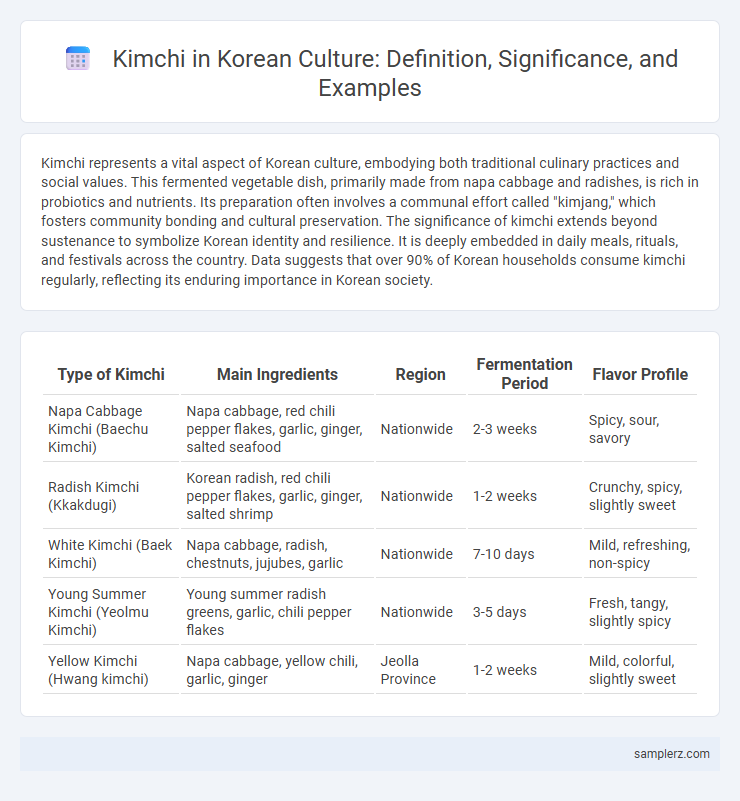Kimchi represents a vital aspect of Korean culture, embodying both traditional culinary practices and social values. This fermented vegetable dish, primarily made from napa cabbage and radishes, is rich in probiotics and nutrients. Its preparation often involves a communal effort called "kimjang," which fosters community bonding and cultural preservation. The significance of kimchi extends beyond sustenance to symbolize Korean identity and resilience. It is deeply embedded in daily meals, rituals, and festivals across the country. Data suggests that over 90% of Korean households consume kimchi regularly, reflecting its enduring importance in Korean society.
Table of Comparison
| Type of Kimchi | Main Ingredients | Region | Fermentation Period | Flavor Profile |
|---|---|---|---|---|
| Napa Cabbage Kimchi (Baechu Kimchi) | Napa cabbage, red chili pepper flakes, garlic, ginger, salted seafood | Nationwide | 2-3 weeks | Spicy, sour, savory |
| Radish Kimchi (Kkakdugi) | Korean radish, red chili pepper flakes, garlic, ginger, salted shrimp | Nationwide | 1-2 weeks | Crunchy, spicy, slightly sweet |
| White Kimchi (Baek Kimchi) | Napa cabbage, radish, chestnuts, jujubes, garlic | Nationwide | 7-10 days | Mild, refreshing, non-spicy |
| Young Summer Kimchi (Yeolmu Kimchi) | Young summer radish greens, garlic, chili pepper flakes | Nationwide | 3-5 days | Fresh, tangy, slightly spicy |
| Yellow Kimchi (Hwang kimchi) | Napa cabbage, yellow chili, garlic, ginger | Jeolla Province | 1-2 weeks | Mild, colorful, slightly sweet |
Historical Origins of Kimchi in Korean Culture
Kimchi, a traditional Korean fermented vegetable dish, dates back over 2,000 years and originally consisted of simple salted vegetables preserved for winter consumption. Historical records from the Three Kingdoms period highlight kimchi's evolution from salted radishes and cabbage to a complex array of regional varieties, reflecting Korea's agricultural lifestyle and seasonal climate. The introduction of chili peppers to Korea in the 16th century transformed kimchi into the iconic spicy delicacy central to Korean cultural identity and culinary heritage.
Traditional Methods of Kimchi Preparation
Traditional Korean kimchi preparation involves fermenting napa cabbage and radishes with a mixture of chili pepper flakes, garlic, ginger, and salted seafood, maintaining authentic flavors through age-old techniques. The process includes salting vegetables to draw out moisture, followed by layering with spicy seasoning pastes before sealing in earthenware jars called onggi for fermentation. This time-honored method preserves the nutritional benefits and rich umami taste, highlighting kimchi's cultural significance in Korea's culinary heritage.
Varieties of Kimchi Across Korea
Kimchi, a staple in Korean cuisine, showcases a diverse range of varieties across different regions, reflecting local ingredients and tastes. In the southern coastal areas, napa cabbage kimchi with a spicy, fermented seafood base is predominant, while the northern regions favor a milder, less salty version often made with radishes. Variations like baechu kimchi, kkakdugi, and oi sobagi highlight Korea's rich cultural heritage and regional agricultural practices.
Kimchi’s Role in Korean Social Customs
Kimchi serves as a vital symbol in Korean social customs, representing family unity and cultural heritage through the traditional process of kimjang, where communities gather to prepare large quantities of kimchi for winter. This practice fosters social bonds and reinforces collective identity, as sharing kimchi during meals epitomizes hospitality and respect. The dish's enduring presence at every Korean table underscores its significance in maintaining social cohesion and cultural continuity.
Kimchi in Korean Festivals and Celebrations
Kimchi plays a central role in Korean festivals and celebrations, symbolizing tradition and communal harmony. During the annual Kimjang festival, families and communities gather to prepare and share kimchi, fostering cultural unity and preserving an intangible heritage recognized by UNESCO. This vibrant fermented dish is not only a culinary staple but also an emblem of Korean identity and seasonal cycles.
Symbolic Significance of Kimchi in Korea
Kimchi embodies Korean identity, representing resilience and communal spirit through its traditional fermentation process passed down for generations. This iconic dish signifies cultural heritage and family unity, as its preparation, called "kimjang," brings communities together annually. Beyond nourishment, kimchi symbolizes Korea's historical endurance and unyielding national pride.
Kimchi and Korean Family Traditions
Kimchi, a staple in Korean cuisine, embodies the essence of Korean family traditions through its preparation during gimjang, a communal activity where families gather to make large quantities for winter. This ritual strengthens familial bonds and preserves cultural heritage by passing down recipes and techniques across generations. The practice highlights the importance of collaboration, respect for nature's cycles, and the value placed on shared meals in Korean culture.
The Influence of Kimchi on Korean Cuisine
Kimchi, a traditional fermented vegetable dish, serves as a cornerstone of Korean cuisine, influencing flavors, preservation techniques, and meal compositions. Rich in probiotics and umami, kimchi enhances the nutritional value and taste complexity of various Korean dishes such as stews (jjigae) and fried rice (bokkeumbap). Its cultural significance promotes communal dining and embodies Korea's culinary heritage, driving innovation in both traditional and contemporary food preparations.
Globalization of Korean Kimchi Culture
Korean kimchi has become a global culinary phenomenon, reflecting the expanding influence of Korean culture worldwide. Its distinctive fermented flavors, health benefits, and traditional preparation methods are celebrated in international food markets, cooking shows, and restaurants. The globalization of kimchi demonstrates Korea's cultural export strength and promotes cross-cultural appreciation through food.
Kimchi as a Cultural Heritage and UNESCO Recognition
Kimchi, a traditional fermented vegetable dish primarily made from napa cabbage and Korean radishes, is a vital symbol of Korean cultural heritage. Recognized by UNESCO in 2013 as an Intangible Cultural Heritage of Humanity, kimjang--the communal preparation and sharing of kimchi--reflects Korea's strong values of family, community, and preservation of culinary traditions. This cultural practice not only ensures the transmission of kimchi-making knowledge across generations but also highlights its importance in fostering social bonds and national identity.

example of kimchi in Korea Infographic
 samplerz.com
samplerz.com